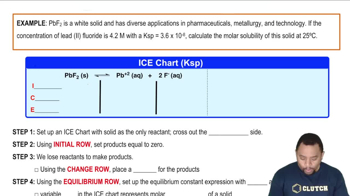Textbook Question
Calculate the molar solubility of MX (Ksp = 1.27⨉10-36) in each liquid or solution. b. 0.25 M MCl2
 Verified step by step guidance
Verified step by step guidance



Calculate the molar solubility of MX (Ksp = 1.27⨉10-36) in each liquid or solution. b. 0.25 M MCl2
Calculate the molar solubility of MX (Ksp = 1.27⨉10-36) in each liquid or solution. c. 0.20 M Na2X
Calculate the molar solubility of calcium hydroxide in a solution buffered at each pH. a. pH = 4
Calculate the molar solubility of calcium hydroxide in a solution buffered at each pH. c. pH = 9
Calculate the solubility (in grams per 1.00⨉102 mL of solution) of magnesium hydroxide in a solution buffered at pH = 10. How does this compare to the solubility of Mg(OH)2 in pure water?
Determine if each compound is more soluble in acidic solution than it is in pure water. Explain. a. BaCO3 b. CuS c. AgCl d. PbI2